Journey to the Surface of Venus
Despite its caustic personality, the planet closest to Earth has answers these scientists want.
:focal(2717x2893:2718x2894)/https://tf-cmsv2-smithsonianmag-media.s3.amazonaws.com/filer/73/03/7303067d-abba-4209-954f-67450f9a414e/08m_on2021_venusflagshipmission-venus_live.jpg)
The current record for a spacecraft’s survival on the surface of Venus is 127 minutes. Set 40 years ago by the Soviet Venera 13, it was a triumph of engineering. Still, two hours after touchdown, it was curtains, and the landers that the Soviets later sent to visit succumbed in half that time. Now a U.S. team is developing a plan to send a more advanced and much more durable lander to Venus—to brave a world of hellish heat, crushing barometric pressure, and a swirling carbon dioxide atmosphere laced with sulfuric acid.
A lot has changed since Venera’s brief working life 39 years ago but not the conditions on Venus. So when I heard that U.S. planetary scientists were plotting an audacious “flagship” mission to revisit Earth’s evil twin, I was reminded of my first Venus encounter. In 1974, even before Venera gasped its last, I was a baby freelance reporter covering the 1974 press conference at NASA’s Jet Propulsion Laboratory (JPL) for the historic Mariner 10 flyby of Venus on its way to Mercury. Mariner 10 was the first U.S. spacecraft to return television images of the Venusian atmosphere, and at the press conference, I found myself in a mob of newspaper reporters who seemed to know little more about the planet than its location—“Second from the sun, right?” In those days, most reporters were proud generalists. On Monday, you covered a train wreck and on Tuesday, Mariner 10’s ultraviolet revelations of a dynamic Venus atmosphere. This was the heyday of Ted Baxter, the booming airhead TV anchor played by Ted Knight on “The Mary Tyler Moore Show.” In Pasadena that day, we had a Baxter type who sprang to his feet and, in a ringing baritone, asked mission chief Bruce Murray, “Tell us, Doc, how long until men walk on Venus?” With extraordinary equanimity, Murray reviewed what our press kits had explained: that the surface temperature of Venus was 842 degrees Fahrenheit, and the surface barometric pressure more than 90 times that of Earth. It would be a long time, Murray assured him.
Whether men and women will ever hotfoot it across the surface, exploring Venus is suddenly a hot topic again in planetary science. NASA announced last June that by the end of this decade, it will send two missions to Venus, and the European Space Agency is planning a third (see “Everyone’s Going to Venus,” p. 63). The much more elaborate Venus Flagship Mission is a concept for the 2030s. In NASA’s mission hierarchy, a flagship is a “large strategic science mission,” and the Venus Flagship study team is definitely going large. It proposes to send a piggy-backed, two-craft lander; a big orbiter; a pair of mini-satellites; and an “aerobot,” a helium-balloon robot (actually two balloons with one pressurized half inside the unpressurized other).
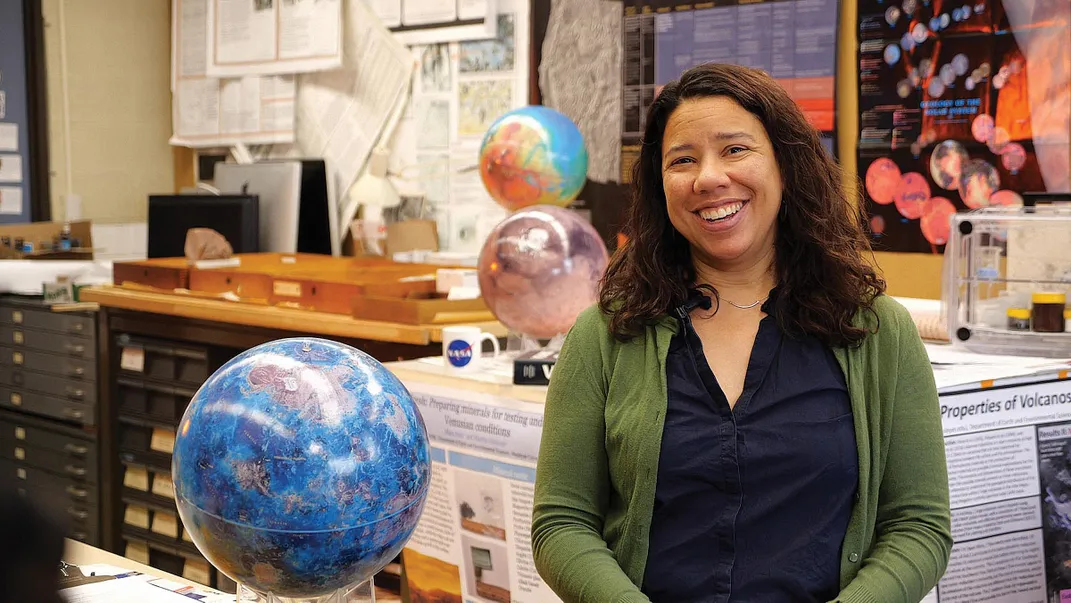
The principal investigator for the Venus Flagship study is Martha Gilmore, an effervescent planetary geologist at Wesleyan University in Connecticut, who cheerfully admits that she has been fascinated by rocks and stars since she was five. Something of a prodigy, Gilmore finished high school at 14, her B.A. at Franklin & Marshall College at 19, and her Ph.D. at Brown University at 26. She worked at JPL before heading back to academia, arriving at Wesleyan’s Earth and environmental studies department in 2000. As a leader in her field and one of the few Black women to be a full professor in a university science department, Gilmore is an ardent advocate for women of color in the physical and Earth sciences.
Venus wasn’t originally her preferred destination. “I actually wanted to work on Mars,” she says. But she got to grad school at Brown as the Magellan Venus orbiter was sending back images of long rift valleys and, as the New York Times reported, “a cracked and splintered crust showing the strains of volcanic activity.” The first spacecraft to map the entire surface of Venus, Magellan used a synthetic aperture radar to capture detail down to a resolution of 390 feet. So little was known about the planet’s surface that the Magellan data had the scientific world abuzz. “When I was at grad school, there used to be three full days of Venus at [an annual meeting of planetary scientists in Houston].” As Magellan wound down, the scientific interest waned. “There’d be like an afternoon on Venus,” Gilmore says.
Her own interest stayed strong, however: “Now that I’ve been on Venus, I can’t go back,” she says and laughs. For a geologist like her, an Earth-size planet “allows you to test so many of the ideas we have in geology that you can’t test on smaller planets or on those that are less active.” Venus is closer in mass and size to Earth than any other planet in our solar system (Mars is just over half Earth’s size). “Every time you ask something about Venus,” she says, “you say well, this is how it should be working, because it works that way on Earth. But it’s not quite working that way.”
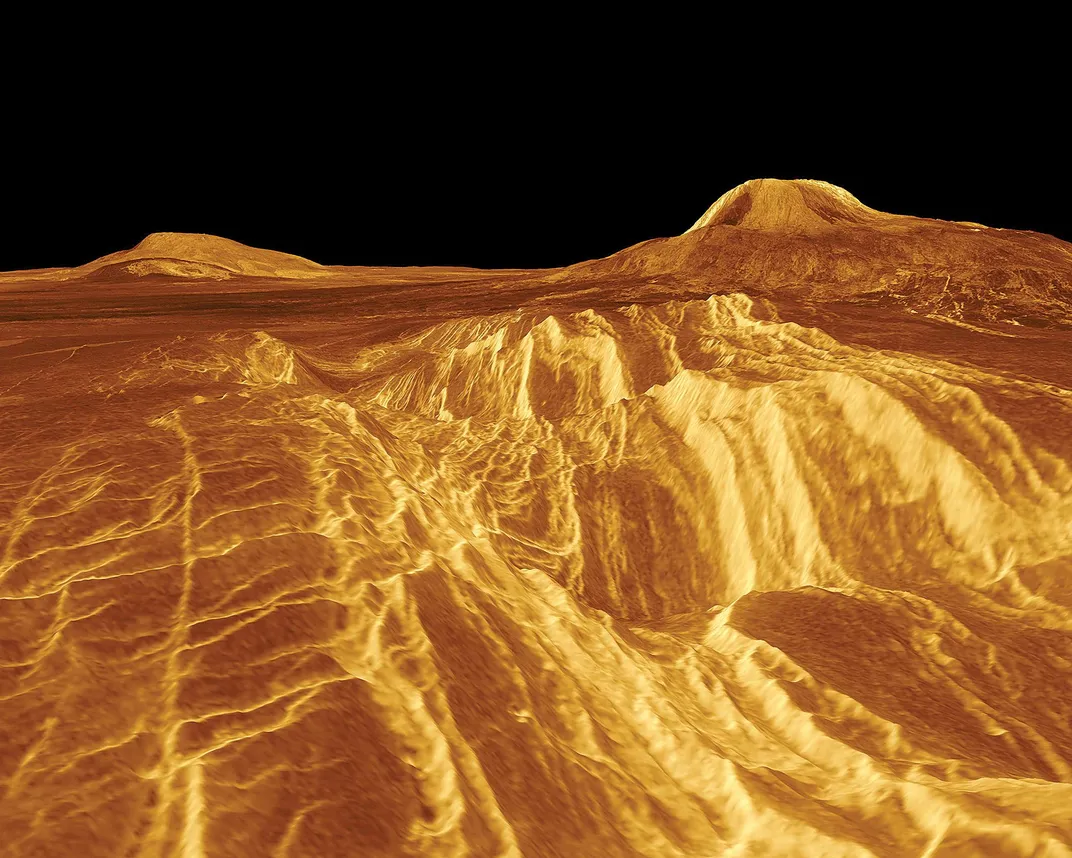
The Way We Were
Planetary and climate scientists have long used Venus as a cautionary tale for what a runaway greenhouse effect could do to Earth. To the scientists who worked on the Flagship Mission study, it is not just a cautionary tale but “the single most accessible example” of a planet that may once have been as hospitable to life as Earth is today. Understanding its evolution could also help a group of researchers whose field of study didn’t even exist in the heyday of Magellan’s orbits—exoplanet astronomers, especially those sorting through the thousands of planets discovered outside the solar system in the last two decades to find potentially habitable ones. “No one is ever going to an exoplanet,” says Gilmore, “but we can go to Venus.”
Michael Way is a physicist-turned-planetary-climate modeler with NASA’s Goddard Institute for Space Studies in New York City. His research group builds computer models of planetary climates—paleo-Earth, Mars, and in the last four years, a possible wet and temperate Venus. The models look forward and backward in time, essentially asking how Venus could have turned from a primordial magma planet to a moderately wet one and then on to a runaway greenhouse disaster, a parched oven cloaked in cloud. His computer models draw on a wealth of data, although Way warns that our knowledge about Venus is so spotty that even basic facts are in question. The conclusion that Venus does not have a magnetic field is based solely on data from Mariner 2, the first successful U.S. planetary satellite, which sailed by the planet in 1962. “I mean, we don’t know if Venus ever had a magnetic field or not,” says Way. “If Venus had a magnetic field the day before the Mariner 2 mission arrived there, we wouldn’t know it.” Better data on magnetism, volcanism, tectonics, surface-atmosphere interactions—the kind of information that would be gathered by a flagship mission—will help in understanding the evolutionary processes of all planets everywhere.
Was there a time in the primordial solar system when a paleo-Venus had a temperate climate with oceans of liquid water, moderate surface temperatures, and a protective cloud cover? The evidence is there to be found in, on, and above Venus.
/https://tf-cmsv2-smithsonianmag-media.s3.amazonaws.com/filer/78/00/78000a80-d7f0-4238-9a1d-53d59cf0dfd8/infographic.jpg)
Hot Stuff
With all its virtuosity in space exploration, the United States has never attempted to land a craft on Venus. The landers proposed for the Flagship Mission are designed for “survivability,” says Gilmore, which on Venus is a relative term. The thermally protected main lander is built to last seven to eight hours. Its life expectancy is four times longer than Venera 13 managed before it croaked in 1982. That’s because of an ingenious design that will use off-the-shelf hardware and electronics that have been available, in some cases, since the Apollo lunar program. The reason the study engineers haven’t designed an eight-hour lander until now is, according to them, nobody asked.
“It’s pretty standard stuff,” says David Steinfeld of the Goddard Space Flight Center in Greenbelt, Maryland, where the engineering and systems architecture of the Venus flagship mission were developed. “Maybe we’re using some higher-temperature, multi-layer insulation materials but the [thermal protection strategies] are fairly standard knowledge we’ve had for 60 years. We’re applying it a little differently.”
The standard engineering solution to keeping electronics functioning in oven-like temperatures is to first isolate them from the titanium shell—“which will be wicked hot,” says Steinfeld. The next step is to surround them with a material, embedded within the space probe’s inner structure, that absorbs heat as it changes phase from solid to liquid. “Think of it as wax,” says Steinfeld. “The substance melts, but the temperature remains the same. Once it’s all melted, the temperature starts to increase. Phase-change material delays the temperature rise. It’s a mass and volume problem, trying to stuff as much of that material as you can into the instrument deck.”
Today’s electronics are also more efficient than those used in the 1980s, says Michael Amato, planetary and lunar business lead at Goddard and an engineering lead on the report. “There were 1,000 watts on Venus landers back then, but on the lander today, we [use] only 500 watts. So half the wattage, the power lasts twice as long.”
Other elements of the mission besides the longer-lasting lander would allow for more data to be collected on the surface. “This [mission] design was done for the Falcon Heavy rocket that can carry a lot more mass to Venus,” says Amato. “As a result, we were able to [include] an orbiter...so that we could talk to it from the lander. Venera had to talk to Earth. That’s a very slow data rate. Our system is designed to talk to a spacecraft that is much closer to the lander.”
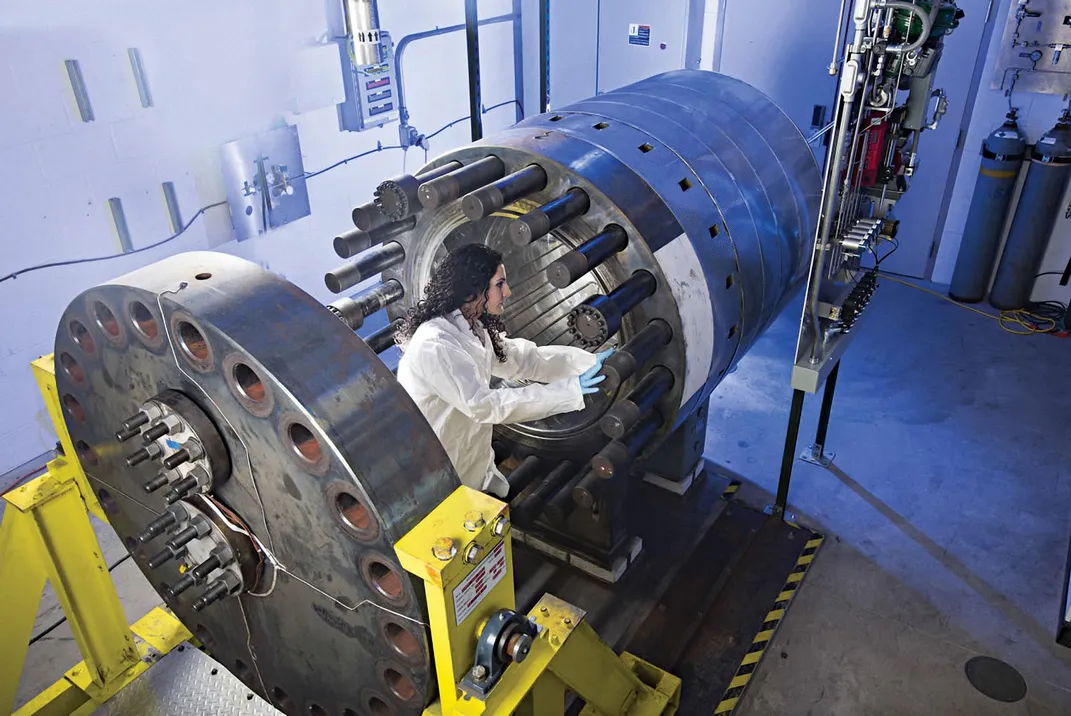
The big, eight-hour lander would not be the only robotic passenger bound for the surface. “We have what I would call a conventional lander in that it’s a lander like Venera,” says Gilmore, “but still, it’s an eight-hour lander. So it will ingest samples. It will zap them with a laser on the outside to look at the mineralogy and measure the gases. But on that lander, we have bolted Tibor’s long-lived lander, which is the little guy, you know?”
Tibor is Tibor Kremic, chief of the Space Science Project Office at the NASA Glenn Research Center in Cleveland where the little guy, known formally as the “Long-Life, In-Situ, Solar System Explorer” (LLISSE, pronounced “Lizzie” by Kremic and his team) is taking shape. LLISSE will be a small weather station and chemistry kit. On the surface of Venus, LLISSE’s “long life” would mean an astounding 60 Earth days (or half a Venus solar day, Venus having an extremely slow rotation). LLISSE is built around a new generation of high-temperature computer chips made not from conventional silicon but from silicon-carbide (SiC), an industrial abrasive used in drill bits.
Extreme heat-tolerant electronics grew out of work in the 1990s at NASA Glenn, originally for aeronautical use inside jet engines and eventually for other types of hot spots. By 2010, electronics engineer Gary Hunter and his research group at Glenn were making progress on SiC integrated circuits for these smart sensors while Kremic was looking about for new uses. He found a bunch of them on Venus, or more accurately in discussions with the Venus Exploration Analysis Group (VEXAG), a professional focus group for the Venus exploration community. “Around 2015,” he says, “I became familiar with the problems they were trying to solve—getting science data from the surface. It just became so interesting.”
/https://tf-cmsv2-smithsonianmag-media.s3.amazonaws.com/filer/97/d7/97d7a8cb-78cc-4578-b7b7-792b918788fa/08z_on2021_venusflagshipmission-infographic.jpg)
When Kremic heard VEXAG members bemoan the crushing heat and pressure on Venus that snuffed out surface probes in minutes, he thought that SiC electronics and other high-temperature sensors could be made tough enough to function unprotected on Venus. SiC instruments could be complex enough to gather real data while staying light enough to get on the “bus,” the spacecraft carrying an interplanetary payload.
Kremic’s test bed for developing SiC circuitry is the Glenn Extreme Environment Rig (GEER), a massive steel cylinder whose interior can be brought to 932°F and 100 Earth atmospheres of pressure. GEER also offers your choice of corrosive gases to mix in. In 2018, a 175-SiC transistor clock spent 60 days under Venus surface conditions inside GEER and came out ticking. “It could have gone longer,” says Kremic, “but we had a scheduling conflict for the chamber.” The SiC test clock was no more powerful than a 1970s electronic calculator, but the next target is an instrument containing thousands of devices on an integrated circuit that would allow LLISSE to handle sensors, data, communications, and power management.
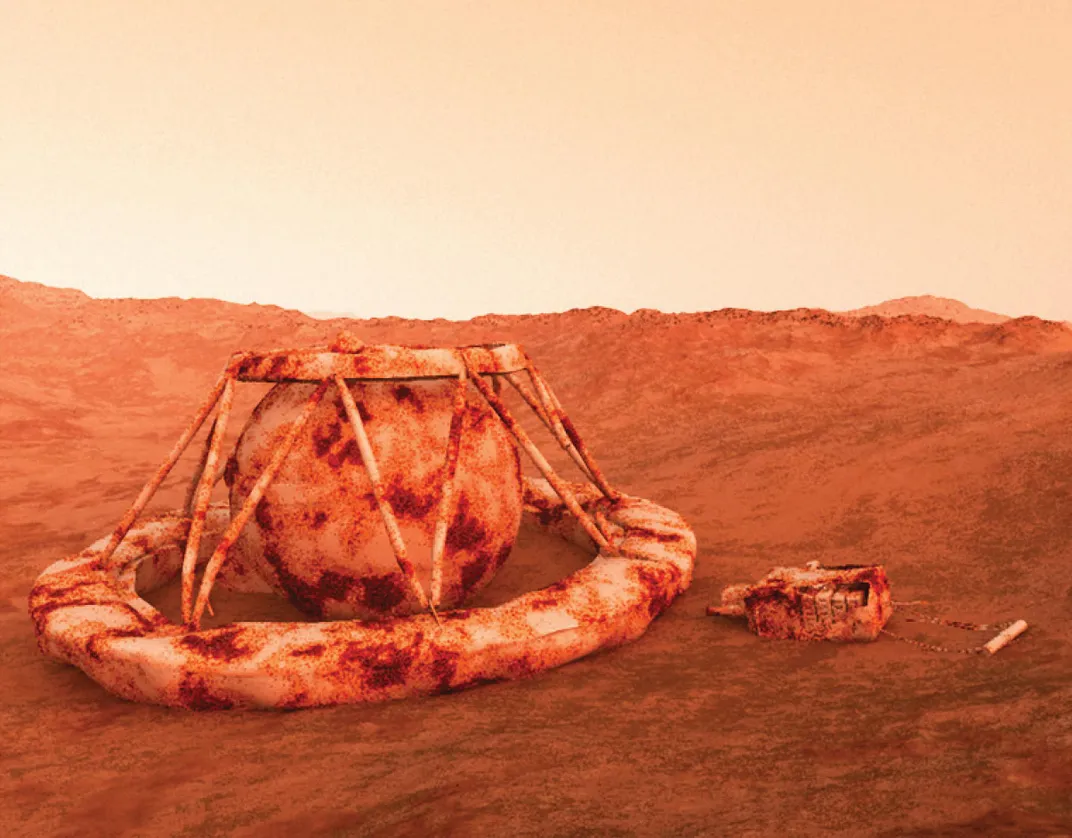
Around Venus for 60 Days
The aerobot is the other eye-catching element in the 2020 Venus Flagship proposal. Once again, the Soviet Union has been there, done that. Its French-designed balloons on the 1985 Vega missions were a huge success. This is what the new flagship study dryly calls, “a significant flight heritage on Venus.” Jeffery Hall, a JPL senior engineer and balloon technologist who advised on the flagship study, says, “it will take some engineering care to make it work,” but the idea of using balloons for planetary exploration is “considered a solved problem because the Vega balloons did it many years ago.”
That engineering care will be tested in the very narrow window between the aerobot’s exit from orbit and deploying mid-air on its way down. “It’s minutes. It’s just minutes,” says Hall. “One thing to appreciate is that the Venus atmosphere is very dense. So it’s different from Mars where the atmosphere is so thin [that] it’s difficult to slow down. At Venus, you can slow down very quickly.”
If everything works, the inflated aerobot, which has an altitude-control system, will spend 60 days circling the planet 12 times on the ambient winds, climbing and descending twice a day on command, while it samples atmospheric gases, scans the surface for seismic activity, and charts meteorological data. The aerobot will measure the composition and microphysics of cloud particles and will record the amounts of, among other things, noble gases. “The wonderful thing about the noble gases is that they’re loners,” says Gilmore. The gases are inert; their outer electron shells are complete, so they have no tendency to bond with other elements. “They don’t like to interact with anybody. Argon is like ‘I’m here, and I’m not doing anything. This is who I am.’ It’s amazing how this works, actually. You can measure the atmosphere of a planet and understand something about its original volatile inventory.
“There are a whole set of gases that are acquired during the birth of a planet during accretion and out-gassing of the original atmosphere. You get your recipe for your planet, and that stays put.” Gilmore adds: “Again, we have a baseline for Mars. We have a baseline for Earth. We don’t know the original inventory for volatile [gases] on Venus yet.”
The weather around the aerobot, 50 to 62 kilometers above the surface, will be relatively mild, says Colin Wilson, an atmospheric physicist at Oxford University who worked on the European Venus Express mission in the 2000s and was on the science team for the 2020 Venus flagship study. Wilson points to a wonderful piece of NASA animation created to illustrate the 2015 High Altitude Venus Operational Concept (HAVOC), a hypothetical study of human exploration in the clouds of Venus. In the animation (airspacemag.com/havoc), two hypothetical Venus astronauts steer their exploration dirigible toward a hypothetical balloon cloud city that looks like a cluster of giant jellyfish floating in bright sunlight above the acid cloud tops. HAVOC may have been an exercise in engineering creativity, says Wilson, “but if you had a human exploration vehicle and you’re getting a bit stir-crazy in your cabin, you could pop open a porthole and walk out on a gangplank or a balcony outside your cabin. You would obviously need an oxygen mask out there but you would not need a pressure suit. You would not need even a sweater because it’s very much Earth-like temperatures.”
The Competition
Such futuristic musings are fun, but Gilmore et al. are focused on the near term. The flagship study proposal was made at NASA’s request for consideration in something called the “Planetary Science and Astrobiology Decadal Survey 2023-2032,” a large planning exercise by the National Academy of Sciences undertaken to help government agencies decide what projects to fund. The Venus Flagship will compete for the panel’s endorsement against other projects focused on other planets and exoplanets, as well as the search for extraterrestrial life and even protecting Earth from asteroid strikes. Even if the Venus Flagship is recommended as the decadal panel’s highest priority, it will have to get in line behind two big-ticket items that got high marks from past decadal reviews but still aren’t fully funded—a Mars sample return and a mission to Jupiter’s moon Europa.
Assuming the unlikely—NASA snaps up the Venus Flagship and makes it a priority mission—the earliest it could launch would be 2031. It would be 2034 before all its parts—orbiter, mini-sats, aerobot, and dual-lander—are in place above Venus and 2035 before the lander makes its descent to the surface. Space exploration is not for the impatient.
Obtaining a decadal survey’s blessing is no guarantee of success for the comprehensive Venus mission, but the flagship study has already demonstrated to the planetary science community—and to Gilmore’s students at Wesleyan and maybe to all budding planetary geologists, physicists, and astrobiologists—the profound importance of getting to know the planet next door, as well as some clever strategies for exploring it. If you can’t stand the heat, design a lander that can. Go big, and go small. Get your head in the clouds. Be brilliant.
Venus is waiting.
Everyone’s Going to Venus
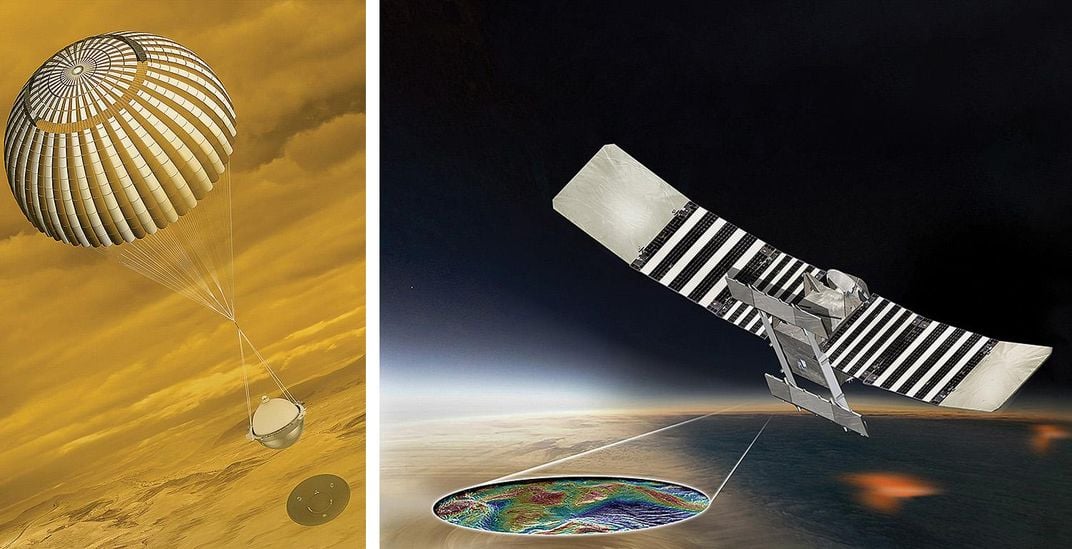
Three Venus missions recently selected by NASA and the European Space Agency (ESA) show how much we still have to learn about our intemperate neighbor. VERITAS (for acronym lovers: Venus Emissivity, Radio Science, InSAR, Topography, and Spectroscopy) will radar map the entire planet from Venus orbit in far higher resolution than was possible for NASA’s 1994 Magellan mission, creating a 3-D relief map that, among other things, might identify a safe but geologically interesting spot for a long-lived lander. The VERITAS launch is proposed for 2026.
DAVINCI+ (Deep Atmosphere Venus Investigation of Noble Gases, Chemistry, and Imaging) will be a probe plus an orbiter. Both will study the atmosphere, but the probe’s mission will be the more daring: an hour-long plunge from top to surface. According to Giada Arney, the mission’s deputy principal investigator at the Goddard Space Flight Center, the free-falling probe will be constantly analyzing trace gases, water vapor, pressure, and temperature, relaying the data back instantly to the orbiter. The probe would emerge from the cloud deck at about 150,000 feet. In its last 20 minutes of life, its downward-facing cameras should have a clear view, in the ultraviolet and infrared, of its target: a highland region of ancient rock called Alpha Reggio. Then poof. It’s not designed to survive impact. Launch is planned for 2029, with flybys of the planet the following year, and the probe’s free fall in June 2031.
ESA recently approved a new Venus radar-mapping orbiter, EnVision, an orbiter that will reach Venus in the early 2030s. Besides analyzing the atmosphere and surface composition, it will carry a radio science experiment that will study the planet’s internal structure.
Two other space programs are considering missions. Russia, the first nation to put a lander on Venus (or any planet) in 1972, has been talking about a future Venera-D lander return. The Indian Space Research Organization (ISRO) also has plans for a Venus orbiter called Shukrayaan-1.